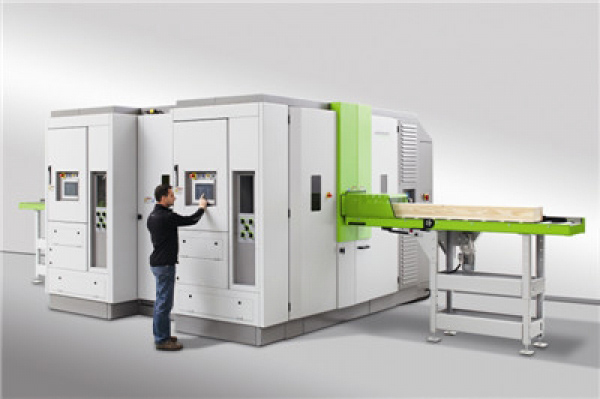For decades, thin-cutting technology has been used worldwide in the production of lamellas. The thin kerf, highest accuracy, a surface to glue and processing the lamellas without additional steps are key benefits for users. The product line includes thin-cutting frame saws and thin-cutting band saws including upstream and downstream processing.
Of the two saw technologies, the frame saw has always been ahead in the past. Now there is a trend reversal and this year, for the first time ever, the demand for the band saw product portfolio will reach the figures achieved by the entire frame saw portfolio: In the wake of the machines themselves, the band saw blades are also gaining ground. The trend is expected to continue, with a stronger demand for band saws than frame saws in the future.
Background Analysis
Market developments trigger this change with a drastic stagnation in the engineered flooring market since 2008 at the basis: Structural overcapacity for production and full warehouses have led to a negative cash flow for customers, and wide country-style planks have been the solution chosen in most cases.
Wider surface planks automatically lead to a flooring trend with a rustic, individual appearance, which in turn leads to an increased demand for flexibility, ranging from wet cutting to outsourcing or very small production quantities.
Another important factor with a major impact is the increasing ecological demand for the most efficient use of natural resources. Thanks to the thin kerf, precise thin-cutting of wood provides the maximum yield, and band saw technology is also superior to frame saw technology in this respect.
The objective is to utilise the entire raw material: rustic wood, wood with defects and core wood are all processed. Designers in Europe are increasingly accepting a rustic look and demand is growing: knotty wood is used for flooring, while core wood, such as core beech, is used for furniture. The demand for a rustic look is also high in North America, however, one focus here is processing recovered wood.

Growing Trend In Asia
A massive technology shift is also apparent in Asia. While demand has centered on frame saws for the last 30 years, the demand for precise thin-cutting band saws is now growing. The reason for this is again the trend towards wide, rustic flooring, which is gaining an additional boost from imported goods.
While indigenous woods were mainly processed in the past, today partially dried logs are being imported that pose major challenges for processors in the precision thin-cutting business. It takes a successful combination of machine and saw blade, supporting technologies such as biological lubricants and modified saw geometries to achieve precision with this raw material. Local dry woods can also be processed; carbide-tipped tools are mainly used here.
Technology For All Capacities
Driven by the need to achieve more flexibility, band saw technology is overtaking frame saw technology. Frame saws tend to be used for mass production and dry cutting. The advantages of the frame saw are the simplicity and reliability throughout the entire sawing process. Both band and frame saws continue to be important, but the focus of the market is clearly on the more flexible technology. Consequently, the focus on advancements is also on the band saw technology.
The customers' requirement of increased flexibility—and for band saw technology—coupled with low volume production makes it essential to provide entry-level solutions for precision thin-cutting of wood.This means thin-cutting band saws for customers who do not need the capacity of existing, bigger machines and thus would not consider such an investment. Another important field are applications where less savings are possible because inexpensive woods are used.
Machine manufacturers face the challenge of pushing forward with the development of thin-cutting band saws. For example, a thin-cutting band saw was launched as an entry-level model for precision thin cutting of wood.
The machine is not a less sophisticated thin-cutting band saw but a more compact band saw, that still demonstrates the full depth of expertise. With a cutting height of up to 160 mm and infinitely variable control of the feeding speed from one to 16 m/min, the thin-cutting band saw can handle wooden blocks up to a width of 310 mm with a kerf starting at 1.1 mm.
The machine features a flexible and sturdy wooden block transportation an integrated continuous cleaning system for both wet and dry cutting applications in order to guarantee a consistently high cut precision and a smooth saw blade entry for better cutting performance.
With the reduced speed at entry of the sawblade into the wooden block, the forces working on the saw are minimised: the deflection of the blade is reduced. Once the blade is completely submerged in the wooden block, the speed of the feed is increased again.(fdmasia)























 沪公网安备31010402003309号
沪公网安备31010402003309号